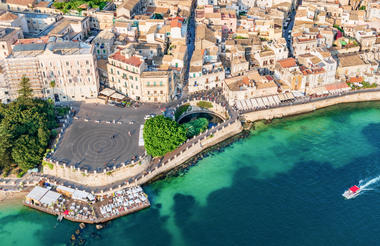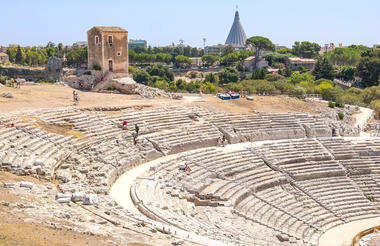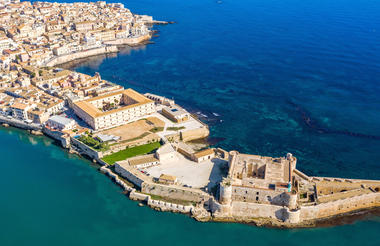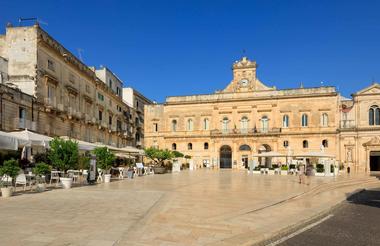The beautiful city of Lisbon lies draped across a string of seven hills on the western Iberian Peninsula and is the westernmost and oldest city in western Europe. Its long and tumultuous history has resulted in an aesthetic characterised by a haphazard combination of old and new; however, the aesthetic chaos of Lisbon only adds to its appeal and its undeniable charm. Bright yellow centenarian trams rattle their way up steep, tree-lined, cobbled streets; ornate ironwork balconies overrun with bougainvillaea sit above elegant outdoor cafes housed in ancient whitewashed, red-roofed stone houses; and a flurry of detailed mosaics decorate the sidewalks. Ancient statues adorn grand squares and hidden gardens. A diverse culinary scene, a plethora of fascinating museums, and numerous castles make it easy to see why Lisbon is one of Europe’s most misunderstood and underrated cities.



Spain’s enormous central capital, Madrid, lies on the River Manzanares and is a city of contrasts. Historical monuments like the impressive Royal Palace stand in stark contrast to state-of-the-art skyscrapers; masterpieces by Picasso, Dali and Velazquez adorn the walls of the city’s world-class galleries alongside contemporary modern works; local chefs display a passion for Spanish food at traditional eateries while chic fusion restaurants operate next door. Madrid’s real attraction lies in the seductive lifestyle of its hedonistic inhabitants; indulging in tapas, hunting for treasures at the El Rastro flea market or partying the night away in one of the many lively nightclubs. Make sure to soak up the vibrant street life of the grand, historic Plaza Mayor, Madrid's central square, and spend a leisurely afternoon on the landscaped lawns at the Parque del Buen Retiro.



Resting on the plains of the Guadalquivir River in the Andalucian province of Seville, the eponymous city is a feast for the senses. Famous for its Flamenco music and dancing, celebratory attitude, tasty oranges and rich Moorish heritage, Seville has reputation for charisma. At the heart of the old city stand three must-see architectural wonders: the Giralda tower, the Cathedral and the Alcazar. The neighbouring medieval Jewish quarter is a wonderful, whitewashed tangle of alleys, bougainvillaea and jacaranda trees, while on the other side of the river Triana is home to sailors, bullfighters, and flamenco artists. Seville travel is about exploring the way of life in these culture-rich neighbourhoods, eating at famed gelaterias, sipping late-night sangrias and, of course, savouring the bitter flavour of the famous Seville oranges.



Resting on Spain’s southeast coast, where the Turia River meets the Mediterranean Sea, the charming port city of Valencia is the capital of the Old Kingdom of Valencia province. The city is renowned for its impressive cultural and architectural complex known as the ‘City of Arts and Sciences’, comprised of a number of futuristic structures including a planetarium, an oceanarium, and an interactive museum. The cobbled alleys of the historic old town are lined with numerous attractions including the bustling marketplace of the grand Plaza del Mercado and the Gothic Valencia Cathedral, home to what many consider to be the authentic Holy Grail. With its thriving nightlife and restaurant scene, quality museums, exquisite Blue Flag beaches, and a characterful historic quarter, it is little surprise that Valencia is developing into a hugely popular tourism centre.



Set on Spain’s gorgeous southeastern coast, the capital and largest city of the Catalonia region, Barcelona, is an exquisite, seaside metropolis. With its dizzying array of architecture and its world-class galleries and museums, artistic delights abound at every corner (most strikingly in the astonishingly whimsical structures designed by the prolific modernist architect Antoni Gaudi). Explore the winding alleys of the picturesque Gothic Quarter, take in the boisterous carnival atmosphere of the world famous, tree-lined La Rambla boulevard, or go on a gastronomical adventure through the city's restaurants. Head to one of the gorgeous white sandy beaches and when the sun sets, join the eclectic all-night party scene. Don’t miss the opportunity to see the phenomenal Sagrada Familia, take in an opera at the sublime Palau de la Musica Catalana, and watch a game at the famous Camp Nou stadium.



Fringing the northern coast of Sicily, Cefalù is one of the most beautiful villages in Italy. This Sicilian beach town features a charming port, pristine beaches and postcard-perfect scenes. Cefalu radiates out from the Duomo, a gigantic cathedral that dominates the main square in the heart of the village. Visitors can look forward to an array of wonderful activities and attractions. Hike up to the Temple of Diana, an ancient Roman temple built in the 4th Century BC. Climb the La Rocca to soak up the stunning view over the village and glittering sea and take an evening stroll along the seafront promenade while savouring the beautiful sunset.



With its visibly smoking craters and the engrossing sulphurous aroma, the unique island of Vulcano, the southernmost of the Aeolian Islands in the Tyrrhenian Sea, rests off northeastern Sicily. Boasting more than meets the eye, travellers who explore beyond the lively Porto di Levante will discover the flourishing vineyards and olive groves of the central plateau’s villages; two unique beaches that are characterised by their beautiful dark, volcanic sand; the warm and welcoming water that surround the island; and the healing mud baths which have made Vulcano famous. This seemingly hidden European gem is an adventure seekers playground and a nature lovers dream, with its plethora of comfortable, yet rewarding hikes up the enchanting volcanoes, all of which overlook breathtakingly beautiful vistas over the rocky terrain and azure waters.



Taormina enjoys an idyllic location, favourably perched on a steep mountainside with panoramic views of Mount Etna, two grand sweeping bays and a picturesque Graeco-Roman amphitheatre. Drenched in sunshine year-round, this chic resort town attracts a steady stream of celebrities and holidaying high-rollers. Despite its unashamedly touristy atmosphere, its natural beauty is undeniable. The town’s chaotic network of winding streets is strewn with luxury designer boutiques, ancient churches and flower-filled balconies adorning beautifully restored medieval buildings and intimate piazzas. Taormina is especially magnificent on clear days when you can view the exquisite flora and flora against a backdrop of snow-capped volcanoes spewing puffs of white smoke into a mesmerizingly blue sky. Make sure to spend an afternoon picnicking in the gorgeous Giovanni Colonna Park.



Set along the Ionian coast of Sicily, the Italian city of Syracuse is known for its timeless beauty, citrus orchards, and ancient ruins fringed by the glittering blue ocean. History enthusiasts can visit one of Sicily's greatest archaeological sites, the Parco Archeologico della Neapolis, home to the 16000-capacity Roman Theatre, the 5th-century Teatro Greco and the Orecchio di Dionisio, a fascinating limestone cave. Once the largest city in the ancient world, and dating back to 734 BC, today the remnants of this spectacular time and the remaining ancient historical sites can still be enjoyed by visitors. Sip on espresso at a local cafe, stroll through the Baroque piazzas, and explore the winding medieval alleyways that traverse this beautiful city. Don’t miss the opportunity to visit the Museo Archeologico Regionale Paolo Orsi, which displays local artefacts and art.



Agrigento is a major tourist hub, primarily owing to the archaeological legacy of the Valley of the Temples, three kilometres below this Sicilian city. This is a misnomer, as it is not really a valley at all but a hill which is divided into two zones: the Eastern zone, containing the bulk of the impressive ruins, and the Western zone, playing host to the splendid gardens of Kolymbetra. Tourists with little time tend to focus on this area, but those on a more leisurely schedule should explore the town itself. Tucked away behind the modern city’s outer ring, a pocket of medieval areas offer bustling night-life as well as the Via Atenea at the centre - a charming suburb packed with modern boutiques, quaint cafes, and vibrant bars.



Palermo lies on the northern coast of the Italian island of Sicily. The Sicilian capital, this ancient city – about 2700 years old – boasts numerous cultural and historical sights. Begin with the UNSECO listed sites, including the Palazzo Reale and churches such as the 12th-century San Giovanni degli Eremiti (with Arabic influences; and cultural treasures such as the 19th-century Teatro Massimo and the UNESCO-listed tradition of Puppet Theatre (performed through-out the city) and detailed in the Museo delle Marionette. Then head to religious sites including the Palermo Cathedral with a 12th-century mausoleum and explore unique attractions such as the macabre Catacombe dei Cappuccini – a cemetery holding mummified corpses (some dating from the 16th-century). Finally, visit markets, artisanal eateries and bars in town, while there are numerous near-lying sights, for fantastic day-trips from the city.



Carved out of rocky mountain slopes in the Basilicata of southern Italy, the ancient town of Matera is a tightly knit cluster of layered stone dwellings twined together by a labyrinth of steep winding staircases and flat dual-purpose rooftops that act as the streets of the level above. The houses, known as the Sassi di Matera, invoke images from the nativity, an impression well-utilised by famous filmed director Mel Gibson as a substitute for Bethlehem in the film 'The Passion of the Christ'. As one of the oldest cities in the world, it boasts a wealth of historic landmarks, such as the Civita district, a natural fortress home to a Romanesque Cathedral, which houses many works of art, including a 13th-century statue called Madonna della Bruna. The Park of the Rupestrian Churches spans over 8 000 hectares and counts over 150 churches, including the impressive Santa Maria de Idris.



Situated in Italy’s Apulia region and facing the Adriatic Sea, Ostuni is famous for its sumptuous olives, idyllic beaches, and ancient, labyrinthian Old Town. Also known as the ‘White City’, the Old Town allows travellers to get lost among its bright, classic, Mediterranean houses or marvel at the intricate frescoes of the Ostuni Cathedral. The village boasts is blanketed by olive groves, which form an integral part of its extraordinary culinary scene. Gourmands can visit a hundred-year-old olive oil farm, see traditional olive mills, or simply delight in the world of flavour on offer at the many award-winning restaurants. Long stretches of soft sandy beaches lapped by warm, azure waters provide the perfect locations for leisurely afternoons in the sun. Don’t miss the chance to see a 25 000-year-old fossilized human skeleton at the Museo Civilta Preclassiche della Murgia Meridionale.



Set in the Apulia region in Italy, the coastal town of Otranto is idyllically set on the stunning Adriatic coast. It boasts s a laid-back atmosphere, picture-perfect crystal-clear blue waters and a rich cultural heritage. History enthusiasts can look forward to viewing the 11th-century Romanesque Otranto Cathedral featuring a jaw-droppingly beautiful medieval mosaic floor, the 15th-century Aragonese Castle, and the little Chiesa di San Pietro, an attractive little Byzantine church. Discover Otranto's compact old quarter and its winding alleyways, visit the small museum next to the cathedral, and sample an array of local Italian cuisine. Other highlights include: soaking up the sea views from the Torre Matta tower at the harbour and relaxing on the pristine Alimini Beach. Don’t miss the Punta Palascìa lighthouse just to the south.



Split, the second largest town on Croatia’s Dalmatian Coast, is famed for its exquisite beaches and the fortress-like complex at its centre - Diocletian's Palace, erected by the Roman emperor in the 4th century. Once home to thousands, this sprawling UNESCO World Heritage site is encircled by white stone walls and contains some lovely courtyards lined with an array of galleries, shops, bars, cafes, cathedrals, and several historical houses. Add to this an impressive backdrop of dramatic coastal mountains and the glistening waters of the Adriatic, and it is not difficult to see why the locals frequently claim that theirs is, "The most beautiful city in the world".



Situated in the Adriatic Sea just off the coast of Croatia, the sun-drenched island of Hvar is a popular summer destination known for its spectacular landscape characterised by lush rolling hills, hidden coves and secluded beaches. The island’s hillsides are covered with olive groves, lavender fields, and cultivated vineyards which produce excellent wines. The island's main town, also called Hvar, is a glitzy playground boasting vibrant nightlife, swanky hotels and elegant restaurants. For visitors looking for some serenity, the rest of the island is dotted with quaint fishing villages featuring magnificent medieval architecture, history and culture. Visitors can look forward to a variety of adventure activities including kayaking, snorkelling, scuba diving, caving, and boating.



Mljet is a green island in the Adriatic archipelago of Croatia’s Dalmatia region. Considered one of the most alluring of the group, it is characterised by its lush Mediterranean forest and long shores lapped by clear waters rich in underwater life. The island is home to two beautiful salt lakes - Veliko Jezero and Malo Jezero. In the waters of Veliko Jezero, St. Mary’s Island hosts the renowned 12th-century Benedictine Monastery, one of the oldest church complexes in the Adriatic, and a significant representative of Croatia’s Romanesque culture. The lakes and the entire north-west part of the island are encompassed by a national park, providing excellent hikes up the hills. It is also possible to rent both bicycles and kayaks. The sheltered and sunny beaches at the Eastern tip of the island offer year-round warm waters, beachside restaurants and idyllic accommodation options.



Dubrovnik is a well-preserved historical city in southern Croatia, known for its distinctive 16th century Old Town, encircled with massive stone walls. After a disastrous earthquake in 1667, the medieval town was rebuilt by Baroque planners and the city’s historic core seems to have been suspended in time ever since. Set-piece churches and public buildings blend seamlessly with green-shuttered stone houses, forming a perfect ensemble relatively untouched by the twenty-first century. Its impressive buildings range from the Baroque St. Blaise Church to the Renaissance Sponza Palace and the Gothic Rector’s Palace, which is now a history museum. Add to this a few exquisitely manicured gardens and some panoramic views of the Adriatic, and it is not difficult to see why Dubrovnik has long been Croatia’s most popular tourist destination.



Dotting the Adriatic Sea off the Peljesac Peninsula of Croatia, the island of Korcula is best known for its dense pine forests, from which it got its name. One of Korcula’s unusual claims to fame is that it is said to be the birthplace of the Venetian merchant and adventurer, Marco Polo. Visitors can enjoy a wide selection of wonderful activities including: exploring the medieval architecture in the town of Korcula, discovering the beaches of Vela Przina and Pupnatska Luka, or jumping on a yacht excursion to explore the nearby island of Hvar. Other popular activities include: biking tours, sightseeing, hiking, sailing, windsurfing, sea kayaking, diving, snorkelling and paragliding.



Situated in central Dalmatia on the shores the Adriatic Sea, Brac Island is blanketed by a forest of cypress trees and endowed with beautiful bays, steep cliffs and endless sandy beaches. Set against a backdrop of sun-drenched hills are several idyllic villages and towns, with the Port of Supetar serving as the main point of entry and the largest town on the island. The town is enfolded by a country landscape of olive groves, orchards, and pine woods that stretch along the coast until the bay of Vlacica. Its harbour is ideal for a stroll along a network of medieval streets lined with local cafes and small shops. The smaller village of Bol is the proud host of one of the most beautiful beaches in the country, Zlatni Rat.



Dominating the Attica region of Greece, the country’s capital, Athens, is one of the oldest cities in the world. For over two and a half centuries, the astonishing Greek temples and monuments of Athens have continued to intrigue and amaze visitors from around the world. This icon of western civilization seamlessly combines ancient history with modern architecture and a surprisingly lively atmosphere. This is particularly apparent in areas at the foot of the Acropolis, Anafiotika, Plaka, Monastiraki, and Thissio where visitors will find numerous extraordinary Neoclassical buildings, trendy and traditional cafes, and shops, and narrow winding streets with historical treasures at every turn. Once you have enjoyed a history and art fix, try some mouth-watering Greek cuisine at one of the city’s fine local restaurants before indulging in the insatiable nightlife at the chic cocktail bars and waterfront dance clubs.



Situated in the Aegean Sea, the Greek island of Naxos is the largest of the Cyclades Archipelago. Its fertile landscape features ancient ruins, quaint mountain villages with sheep-dotted slopes, and vast stretches of magnificent beaches. With their crystal-clear waters, soft white sands and watersports such as swimming, windsurfing, kitesurfing and surfing on offer, the beaches here provide the ultimate holiday experience, while the island’s lush interior makes it an ideal destination for hiking and mountain biking enthusiasts. Make sure to visit the mysterious Cave of Zas, filled with incredible stalactite formations and dedicated to Zeus in ancient times. The wide variety of historic attractions includes breathtaking Venetian mansions, Byzantine country churches, and the medieval old quarter of Kastro, with its centuries-old stone paving, arches and buildings.



The old port city of Chania is located on the beautiful island of Crete, guarding the entrance to Greece’s spectacular Chania Peninsular. Known as the ‘Venetian Harbour’ and by the names Hania and Chania, this magnificent city boasts a charming quarter filled with labyrinthine lanes, Turkish architecture, and beautifully restored townhouses. Hike through spectacular mountains and gorges, discover archaeological sites, and explore ancient monasteries. Visitors can also enjoy a stroll along the Venetian harbour, sip on a cocktail at one of the many cafes lining the promenade, and sample some of Crete’s best cuisine. Don’t miss visiting the striking Venetian Lighthouse, as well as the wonderful Naval Museum, where you can see incredible displays from the Bronze Age until the present, including war relics, paintings, models of ships and nautical instruments.



The picturesque Greek town of Rethymno, set on the honey-coloured shores of the northern coast of Crete, offers a rare combination of history and modern-day luxury, with its ornate Venetian-era old town, tropical beaches, welcoming warm water, and mouth-watering Cretan cuisine. Rethymno provides a lively atmosphere and an eclectic mix of architectural gems. Explore alluring museums, beautiful churches, and historically significant landmarks. Most iconic among these are the magical Fortezza of Rethymno, the insightful Archeological Museum, the striking Guora Gate, and the magnificent Municipal Garden. In the heart of the magical old town lies the picture-perfect Venetian Harbour (possibly the most romantic area of the city), travellers can enjoy tavern-lined streets and admire the views over the azure, boat-bobbed waters.









